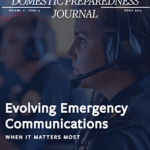- Articles, Emergency Management, Emergency Medical Services, Science & Technology
- Brian McGinley
There are moments during a disaster that something needs to be purchased. Depending on the nature of the purchase, it could be something small, perhaps something that can be purchased with a company credit card. On the other hand, it could be a purchase for millions of dollars and, not only do procurement laws come into play, but so could federal procurement laws if the organization is going to seek Federal Emergency Management Agency (FEMA) reimbursement after the disaster closes. In the moments of needing to spend large dollar amounts, the procurement office should be consulted, not because all purchases need to go through that office, but because they work year-round to establish relationships, contracts, and price lists with suppliers that could save time, money, and allow focus to be on the disaster at hand.
During COVID, the global supply chain was greatly disrupted. Organizations with enormous purchasing power seemed to be buying up all the supplies leaving smaller organizations to deal with price gaugers, brokers, and resellers, or to hope for some level of government to help them. However, organizations, even smaller ones, with established contracts and relationships with local firms had opportunities for small orders here and there based on the working relationship throughout the normal year. Those close ties, being on a first-name basis with the local medical or facilities supplier, allowed some organizations to remain stocked with the supplies they needed and the confidence in the local supply chain for leaders to make informed decisions about safety, reopening, or supply distribution.
The essential mission of procurement within an organization is to maintain the supply chain and facilitate the acquisition of goods and/or services. Strategic sourcing is a long-term solution using all the information that is available to make data-driven, forward-thinking sourcing decisions. Instead of waiting for purchasing requests to come through and merely fulfilling transactions, a strategic outlook will analyze the data available to see where value can be created by looking at what matters most to the organization. The value added to the procurement depends on what the end-user considers the highest priority. In some instances, it could be time to first use; perhaps it is the total cost of ownership, or it may be securing business continuity and financial health. This emphasis can be weighted in the evaluation process to avoid the traditional government procurement pitfall of having to award to the lowest bidder.
Benefits of Strategic Procurement
Some of the main advantages of strategic procurement for business continuity and disaster recovery is pre-negotiated pricing lists and satisfying all procurement rules prior to the incident. During emergencies, it is not uncommon for vendors to take advantage of the market disruption and increase prices. There are even instances where vendors with pre-negotiated prices still try to take advantage of the crises to abandon their obligations. Penalties can be included by the Procurement Department into the pre-negotiated contracts for not honoring the pricing lists. With pre-negotiated contracts for goods and/or services in place, there can be a predetermined list of commodities and services with listed prices almost as a disaster catalog. This catalog of available resources would be a vital component to any disaster recovery or disaster risk management plans.
By taking a more proactive approach, the decision makers in partnership with procurement can set up a more resilient supply chain for the organization, including multiple vendors in case of disruption. By utilizing existing options, such as the U.S. General Services Administration (GSA) Multiple Award Schedule (if eligible), or state versions of the same concept, there can be a multitude of options available to order from existing pricing agreements monitored and awarded by government agencies. Individual organizations also have the option of awarding their own multiple award schedules by issuing a solicitation for a range of products and services and awarding contracts to multiple vendors to create a stable supply chain through multiple outlets. This is very difficult to do during an emergency and, by not having these agreements in place, organizations struggling to find product could be held captive to the fluctuations in supply, demand, and price.
The risk of disruption and price gauging is minimized simultaneously by using pre-existing agreements. Diversification is key to dispersing the potential impact and risk to the organization. Suppliers/vendors are just as susceptible to the forces of the marketplace during an emergency. In serious or widespread disasters, some of these suppliers will be unable to deliver under their agreements or be subject to bottlenecks within the supply chain that limits availability. Working with vendors before the emergency can provide an understanding of their business model and how resilient the business is under normal circumstances.
Global supply chain challenges and opportunities are evolving. Organizations using these strategic procurement practices have a distinct advantage.
Questions about operational resiliency, especially surrounding the supply chain, and business continuity plans can be requested and reviewed during the request for proposal or request for qualifications. This information informs the stakeholders about the suppliers’ capabilities and limitations and provides worthwhile insight into the strengths and potential liabilities of a supplier/partner. This vital information can be much more valuable than just a price list. Deploying a strategy of redundancy and having multiple suppliers to choose from reduces this risk, but having suppliers spread out geographically (even internationally) could also reduce the risk during localized events.
Action Items
Here are some steps to discuss with the procurement office within the organization:
• Supply chain assessment – An assessment of the supply chain used by an organization will include things such as spend analytics (looking at where the dollars go) to identify the suppliers that are most integrated into the organization’s business processes. These suppliers will be the most crucial for business continuity and identifying critical functions for supplier diversification. When all the various internal departments involved with the procure-to-pay process are involved and made aware of the critical role played in the business continuity plan, proactive approaches can be made (in conjunction with business impact analyses) to make internal processes resilient.
• Strategic development – Value creation is important for every department or unit within the organization. Procurement Departments and all the members of the supply chain have the capability to shape a sourcing strategy for overall productivity and business continuity. Contingency plans, disaster recovery plans, and business continuity plans, including those that require alternative or emergency suppliers, are established, along with key performance indicators (KPIs) for internal process efficiency, vendor performance and compliance, etc.
• Performance management – To hold suppliers accountable for the goods and/or services being provided, KPIs are closely monitored and utilized to adjust the sourcing strategy should suppliers no longer add value to the organization’s supply chain. Contracts and agreements drafted for suppliers should include the expectations for performance as well as communication frequencies and standards to keep the relationship trending in a positive direction for the mutual fulfillment of each organization’s goals.
Disaster purchasing does not in itself need to be a disaster. The mechanisms and relationships established for day-to-day operations can be leveraged during disasters to cooperatively add value to the acquisition of required goods and/or services. The goal of supplier management is being able to call the local sales representative, refer to them by their first name, and tell them any challenges. Then, two organizations with sufficient resources work together to solve a mutual problem, not solely for the sales commissions but to help a business partner. Global supply chain challenges and opportunities will continue to evolve and change at an ever-increasing frequency, and organizations with secure and resilient supply chains have a distinct advantage in the future global marketplace.

Brian McGinley
Brian McGinley, DBA, is the Section Chief, Finance and Administration for the Texas Division of Emergency Management and came to work for the agency in July 2021 from another Texas A&M University System member, Texas A&M University-Commerce. There he served as the contracting officer for the organization and worked as a business analyst to help department streamline business processes for efficiency and automation. Prior to joining the university, he began his career as a procurement specialist at the National Aeronautics and Space Administration (NASA) Shared Services Center at Stennis Space Center in Mississippi and became a lead for the NASA Small Business Innovation Research and Small Business Technology Transfer Program, processing over 1,000 contracts and purchase orders with an annual program spend of over $100 million.
- Brian McGinleyhttps://domesticpreparedness.com/author/brian-mcginley






